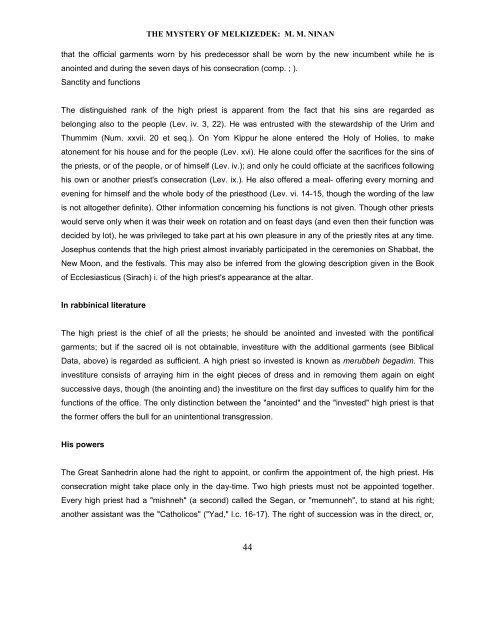Mystery of Melchzedek
You also want an ePaper? Increase the reach of your titles
YUMPU automatically turns print PDFs into web optimized ePapers that Google loves.
THE MYSTERY OF MELKIZEDEK: M. M. NINAN<br />
that the <strong>of</strong>ficial garments worn by his predecessor shall be worn by the new incumbent while he is<br />
anointed and during the seven days <strong>of</strong> his consecration (comp. ; ).<br />
Sanctity and functions<br />
The distinguished rank <strong>of</strong> the high priest is apparent from the fact that his sins are regarded as<br />
belonging also to the people (Lev. iv. 3, 22). He was entrusted with the stewardship <strong>of</strong> the Urim and<br />
Thummim (Num. xxvii. 20 et seq.). On Yom Kippur he alone entered the Holy <strong>of</strong> Holies, to make<br />
atonement for his house and for the people (Lev. xvi). He alone could <strong>of</strong>fer the sacrifices for the sins <strong>of</strong><br />
the priests, or <strong>of</strong> the people, or <strong>of</strong> himself (Lev. iv.); and only he could <strong>of</strong>ficiate at the sacrifices following<br />
his own or another priest's consecration (Lev. ix.). He also <strong>of</strong>fered a meal- <strong>of</strong>fering every morning and<br />
evening for himself and the whole body <strong>of</strong> the priesthood (Lev. vi. 14-15, though the wording <strong>of</strong> the law<br />
is not altogether definite). Other information concerning his functions is not given. Though other priests<br />
would serve only when it was their week on rotation and on feast days (and even then their function was<br />
decided by lot), he was privileged to take part at his own pleasure in any <strong>of</strong> the priestly rites at any time.<br />
Josephus contends that the high priest almost invariably participated in the ceremonies on Shabbat, the<br />
New Moon, and the festivals. This may also be inferred from the glowing description given in the Book<br />
<strong>of</strong> Ecclesiasticus (Sirach) i. <strong>of</strong> the high priest's appearance at the altar.<br />
In rabbinical literature<br />
The high priest is the chief <strong>of</strong> all the priests; he should be anointed and invested with the pontifical<br />
garments; but if the sacred oil is not obtainable, investiture with the additional garments (see Biblical<br />
Data, above) is regarded as sufficient. A high priest so invested is known as merubbeh begadim. This<br />
investiture consists <strong>of</strong> arraying him in the eight pieces <strong>of</strong> dress and in removing them again on eight<br />
successive days, though (the anointing and) the investiture on the first day suffices to qualify him for the<br />
functions <strong>of</strong> the <strong>of</strong>fice. The only distinction between the "anointed" and the "invested" high priest is that<br />
the former <strong>of</strong>fers the bull for an unintentional transgression.<br />
His powers<br />
The Great Sanhedrin alone had the right to appoint, or confirm the appointment <strong>of</strong>, the high priest. His<br />
consecration might take place only in the day-time. Two high priests must not be appointed together.<br />
Every high priest had a "mishneh" (a second) called the Segan, or "memunneh", to stand at his right;<br />
another assistant was the "Catholicos" ("Yad," l.c. 16-17). The right <strong>of</strong> succession was in the direct, or,<br />
44


















